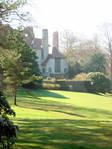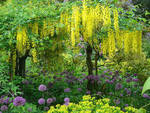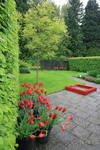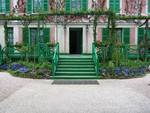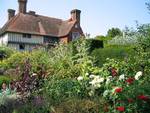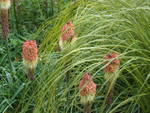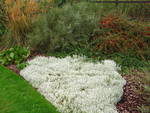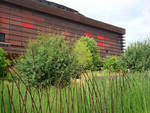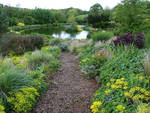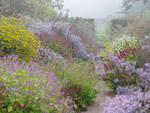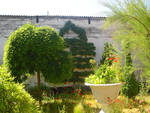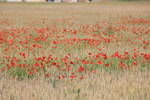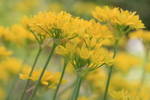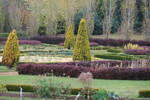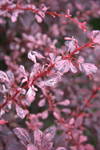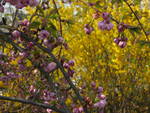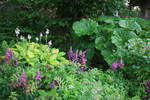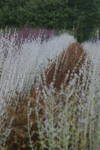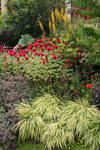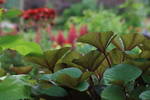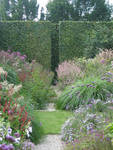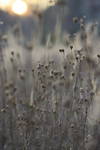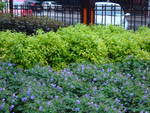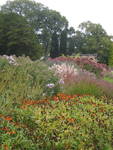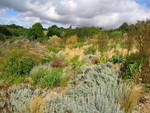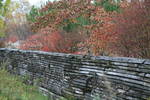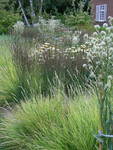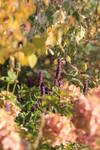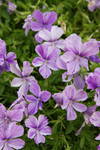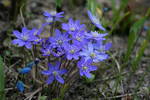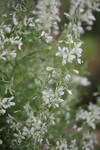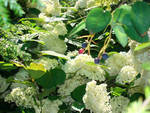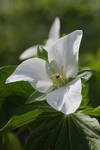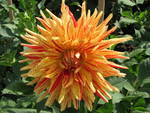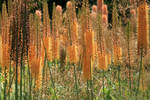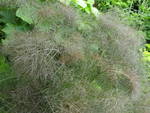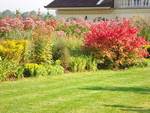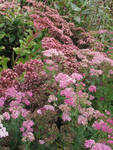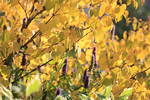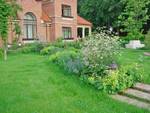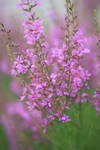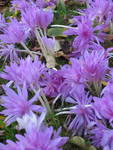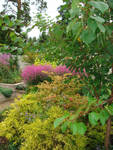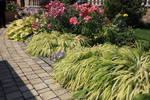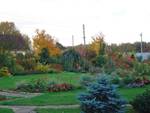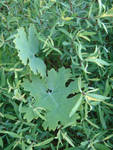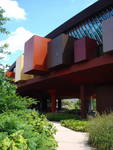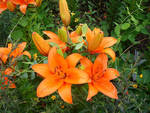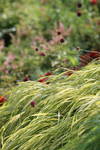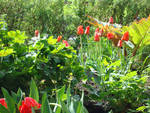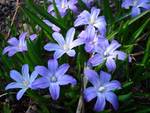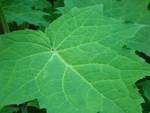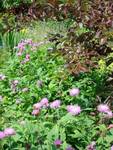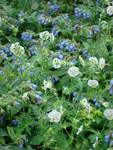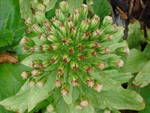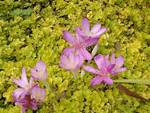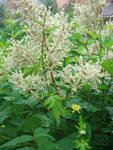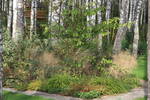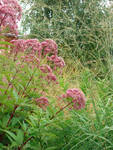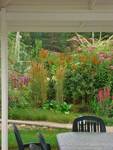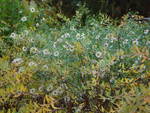
|
|||||
|
|||||
|
There are no useless plans or useless work. There are sleepless nights, digging in the memory and in the soil, seeing round the plants at dawn and in the sunset, after and during the rain, in autumn and in winter; there are journeys to the gardens, with discoveries of new varieties and new combinations. And the reward is inspiration when you succeed to do anything and when the flower garden still uncaptured on paper already exists as an image in your eyes.
Chapter 1. Lessons of the Masters.
Gertrude Jekyll
She used to say: “I don’t think the horse likes its new collar. I’m sure I don’t like my new shoes”. Her shoes tell us about miss Jekill a lot more than her numerous portraits.
Rosemary Verey
Nowadays Barnsley House is open for visitors with its hotel and boutique, and the garden is taken even too much care of. Here you can feel the absence of the mistress that let the forget-me-nots and daisies grow through the paving and wasn’t afraid of the bishop’s goutweed blooming under the crowns of purple apple-trees.
Mien Ruys
“Moderation in landscape design is a luxury” – wrote Piet Oudolf. This can be attributed to Mien Ruys’ creative work.
Claude Monet
The orchard spreading out in front of the house is divided into two parts by the Grand Alley covered with gravel which is carpeted in the second half of the summer by the blooming Indian cress. It was Monet who invented this trick and the other one – long narrow parterres that can be seen from the windows of his bedroom.
Christopher Lloyd
I remember that during my first visit to Great Dixter, Lloyd’s garden, I was forcing my way through the thicket of purple saltbush vainly trying to explain to myself what I was doing there.
Roberto Burle Marx
Apparently I had to find myself on a different continent to understand: most of all I like this very “jungle”-garden with high architectural plants and the delicate game of textures.
Alan Bloom
All over the world Alan Bloom is known as the creator of island parterres. A modern scenery garden is unthinkable without them.
Piet Oudolf
He is the notorious and unpredictable designer whose ideas are taken by numerous gardeners. Apparently before he appeared they were afraid to confess that they are inspired by field and meadow sceneries and not by excessively groomed parterres and lawns.
Beth Chatto
I like her attitude towards aggressive plants and weeds: “Each gardener should decide which plant is the weed in his garden. The question is whether the plant is injurious to the others and how beautiful it is”. Beth Chatto wrote this about monk’s hoods and it makes me remember my eternal discussions with specialists about the goutweed “Variegata”, the comfrey and all the other “pleasures” of a gardener’s life. Up to now those who win are the plants that go on living in my garden.
John Brookes
I remember some years ago showing John the picture of his garden. Under the old apple tree coexist Еndymion hispanicus and pretty hillocks of stonecrop in the thicket of goutweed before its blossoming. When I asked John about the goutweed he said: “Well, that’s the idea!”
Gilles Clement
In 15 minutes you are going to make a way of 400 years.
Judy Pearce
It’s important that the parterre size corresponds to that of the entire garden – small flowerbeds would have been lost on an enormous slope.
Patrick et Sylvie Quibel
From the very opening of the garden during 14 years no landscape design magazine missed the opportunity to write about the Feather Garden comparing the effect produced by the plants to the french revolution.
Chris Ghyselen
I also enjoyed the idea of the plants emerging up to the sky. The blue of the sky is a wonderful background for a sea of plants.
Han Njio
Ask me in 10 years why do I remember the garden by Han Njio and I’ll tell you: fancy plates and gravel loan.
Chapter 2. Сolour. Shape. Texture.
Color
Red and Yellow
• Oriental Poppy
That’s the most joyous combination you can see in the garden from April till June. The poppy and the doronicum don’t have a long period of bloom, but hardly anyone can deprive himself of the pleasure of contempating these plants for just a couple of weeks.
Yellow and purple
• Alpine Violet
This combination is very suitable for partial shade, moist soil, besides it’s all-season, since we take advantage not only of the flowers, but of the foliage. Dark violet leaves, my favourite heuchera «Palace Purple» and the eupatorium «Chocolate» are shaded by the bright splashes of the milium and the hop «Aurea».
Magenta and purple
• Barberry «Rosy Glow»
On the background of the barberry «Rosy Glow», which seems rather frivolous because of the many pink spots, strongly resembling freckles, stand out the purple blazing star verticals. A new variety of the sedum «Picolette» refreshes the whole picture, contrasting with aster lateriflorus «Prince», surrounded by the neon helianthemum.
Pink and yellow
• Lupins «Chandelier»
I’ve mentioned already the beautiful combination of blooming tulips with the lupins’ foliage at the background. In this composition the simultaneous bloom of the aubrieta and the early tulips “Foxtrot” is followed by that of the tulips “Angelique” that resemble the peonies. And it’s accompanied by opening lupine flowers with a golden haze of the gentle meadowsweet, which by mid-summer suddenly turns into golden balls with flat, bright pink inflorescences shields - they are trying to get lost in the geranium varieties «Red Admiral» in the way that makes everyone think that it’s the geranium golden foliage, not the meadowsweet.
Shape
Architectural Plants
It is important to stand out from the crowd, to be worthy of a single planting, to become the thematic plant of the flower garden, in a word, the element that’s going to emerge in the memory first when you imagine the garden.
Whiff plants
I give this group of plants special attention, just as to plants with ball-shape flowers. And they both allow you to create a unique atmosphere of romance in the garden.
Chapter 3. The Flower-Garden Shape
Unilateral View Flower-Garden
In order to make a long unilateral-view flower-garden look harmonic, don’t doubt to use the repetition - technique: repeat separate plants or groups of plants, or architectural details.
Island parterres
The beautiful lines of the scenery island flower beds, brave and resilient, will look well even in winter. At the same time we can not consider only the sight “from above”: often a beautiful and complicated schematic design is meaningless when planted, and, conversely, very simple lines can look flawless.
The double boarder
If you want to make a double border look natural, you can change the course of the track, making it more tortuous. I did so in the design of the terrace (track length of 30 m and width from 1.2 to 3 meters). It narrows, then expands – it gives the lawn a very organic look. At the same time boundaries are blurred – by alchemilla, bergenia or my favorite – false sedum «Fuldaglut».
The open boarder
You can not go inside a flower-garden of unilateral view or penetrate into island beds - this is only possible with the open border, where the paths play the role of "connective tissue".
The Narrow Strip
My customers were courageous enough to prefer traditional annual plants to a sort of a private garden. Residents of nearby houses often approached, asked the names of plants, declared: "And I have it!" - and got excited like children recognizing them.
New Classics
The historic layout is filled with herbs and fashionable perennials: asterworth, euphorbia, eupatorium, aster, cimicifuga. The result was stunning and unpredictable.
Chapter 4. Constructing a Flower Garden
If you're told a beautiful garden is easy - don't believe it.
How to start
Even in a “young” composition immediately after planting it attracts the attention and sets the rules. The neighbors who admire this beauty from the first floor are lucky.
Thematic Plants
These plants must always stand out, they are lead other subordinate plants.
The Cornerstone
I consider herbaceous perennials not only as the beautiful flowers, but also as building material for the garden.
To Mix or not to Mix
Planting in blocks is easy to take care of, the mixed planting in turn is more decorative. The one in blocks is statical, changes are insignificant, while mixed planting lets us see the constant change of scenery.
Seasonal Coloring
Winter is strict and does not like colors. Even the sky is gray-white.
Seasonal Combinations
The example of seasonal combinations that can not be brought together is given on purpose.
Blooming Calendar
You should make it yourself by all means if you are seriously decided to learn the art of creating a flower garden.
Making the Plan
Let’s take a concrete composition as an example. I’ve been observing it from my window for 10 years already, I see it change and it doesn’t bother me at all (it means the choice was right).
Chapter 5. Monochrome Flower Gardens
The Whites start and Win
30. Hydrangea arborescens «Annabelle» 31. Magnolia stellata
The Yellow Sea
You may ask why the garden is called yellow, if red-brown geranium has dark plum color, veronica is blue, sage is blue-violet and roses, rhubarbs and poppies are red?
The Unloved
Astilboides – no one knows if this plant would have been so interesting for us if it wasn’t for the light color of its leaves. Light green with soft texture, forming huge “plates”, they are also splendid during the early growing season. In the beginning of spring the leaves have not deployed yet and are light brown.
Mandarin, Lime & Co
Euphorbia multicolor has also plenty of advantages: bright yellow-green bracts, globular bush shape, which is maintained throughout the season. Those who meet it for the first time ask the same question: "How many times over the summer it should be cut to achieve this shape?" Fortunately the "barber" is nature itself.
Mr. Orange
1. Hippophae rhamnoides 2. Loniсera brownii «Dropmore Scarlet» 3. Lonicera caprifolium
The Secret Room
The space is big enough, so you can install garden furniture and enjoy the game of textures of the luxurious dark color. This color should be viewed from close, because at a distance it looks like a black hole.
Fire Color Now the spindle found a place on the border of the flower bed and the lawn, waiting for its moment of glory when the leaves will start flaming.
Pink Wind
All tints of gray, a lot of cereals and tinges of pink: you still doubt that the wind can be pink?
Combining combinations
My suggestions to leave aster in smaller quantities, at least one bush, did not find approval. It was my mistake when designing the flower garden. I was not able to convey to the customer the true characteristics of the plant, to explain to him how it may influence the view of the flower bed, and become the dominant plant instead of being a supplement.
In one breath
The flower garden resulted amazing. Again I remembered having promised to myself not to plant without a plan; but when you see such a result, the promise can be forgotten.
Inspiration from Chelsea 2006
Orange butterflies like to come up during the flowering of catnip apparently in order to match the apricot color of roses.
Chapter 6. Cold Flower Gardens.
Cool Fall
The color range is chosen in order to make it easy to replace any plant by a similar one. The only ones that shouldn’t be changed are the plants that started the garden – cornus alba “Aurea”, hakonechloa “Aureola” and the aster “Twilight”.
Eternal Spring
As the blue-yellow range comes to its end in mid-July, the bright juicy combination of yellow-green and magenta colors stays for the rest of the summer.
Cold Rosarium
In the first half of summer, before the flowering of roses, the main decoration of the rosarium is the Cheddar Pink, which should be cut immediately after flowering.
Nonrosarium
Elena Ivanovna Sedova calls “nonrosarium” what I called “rosarium” in my projects.
Peaces of Cake
Do you like round lawns so much as I do?
Lawn Games
Two, three, five plants from this garden combined fit each other perfectly. You can take advantage of it if you don’t have time or space to make a large flower garden. Let’s train playing this exciting game – making plant combinations.
Chapter 7. Ardent Flower Gardens
The idea was hiding behind the mask of my oriental rug, bought in a shop of St. Petersburg; it was interpreted as a red double border in Hidcote Manor; burned in the sky with sunset colors, finally got its present name – Ardent Garden.
The Beginning
The goal was achieved - the color shock was a success! It’s worth mentioning that the author was the only pleased by the flower bed. And I was flattered when I saw a queue while we were disassembling it. Can you guess why all those people came?
Southern border
This enormous and labor-intensive flower garden has the length of 97 m and the width of 3 to 6m. There were 72 items in the assortment list.
Garden Eclectics
Red roses are take a sun bath in a haze of cereals.
Firebird
There are no roses in this flower garden, in spite of that it’s classified "ardent”. All the attention is attracted by the foliage of architectural plants, by the elegance of herbs, and the interaction between them.
Chapter 8. Flower Gardens for Special Places.
The White Guard
If you like annuals, you can add white violets in the spring (take those of uniform color, without spots) and sow the cosmos, thus the parterre will look even more mysterious. The high cleome is also beautiful. Any idea can be developed, complicated or simplified - it's up to you.
Festive Geometry
“And do you like the poetry of poems?” – this is part of a dialogue about beauty from the Russian movie “Office Romance”.
Windows
This plant surprises us in autumn when it’s strewed with pale-yellow bell shaped flowers.
Purple Haze
• Betonica grandiflora • Centaurea dealbata
Intrigues of the Spanish Court
What the customer wanted was: high plants near the house, the presence of cereals, the blue – white – cream – pale – yellow range, roses if possible; but the main idea was that of a “the civilized jungle”, an “intrigue – garden” preserving gala spirit.
Russian Garden
You can taste the wild strawberries that make a carpet at the foot of a group of birches.
Revenge to the Lawn
Reading these lines no gardener will understand that it’s all about the comfrey.
Butterfly Garden
• Calamagrostis x acutiflora «Karl Foerster» • Buddleja + Veronica longifolia
Colorful Shells
Clouds of crambes appear only for a month on the border of the gravy garden and the bush-zone, then they disappear till June of the next year.
Milky Banks
Astrantia creates a slight haze. Three types of hosta are planted, differing in height and color: the blue “Big Daddy”, the miniature hosta lancifolia with dark-green lucid leaves and one of my favourites “Regal Splender” with milk-white lining of the leaves that fits perfectly the flowers of the knotweed, the eupatorium, the iris variegata, the aruncus, the ground-elder and of course the lily of the valley.
Three Stars
Thus, these three plants make the clue of the composition, all the rest just accompany them.
Window View
The composition has the Polygonum polimorpha in its basis – an impressive plant blooming in June – and a stream of white irises “Snow Queen” with sprinklings of onions “Mount Everest”.
Maple Wood
The crackberry “wallpaper” gives the opportunity to create three compositions on the island-parterre. In spite of their self-sufficiency they are parts of a grand winter plan
Cereal Present
It’s hard to please a landscape designer, who’s at the same time a photographer specializing in gardens, who created his own garden after visiting the best ones around the world. Nevertheless…
Raspberry Season
• Echinops bannaticus «Blue Globe» • Hemerocallis middendorfii • Amsonia orientalis + Deschampsia caespitosa
To Us and to You
The angle is maintained by the willow (salex ledebouriana) planted in a bunch. Three pink-white salex divide the bordure space in two halves and the high miscanthus, eupatorium, makleaya, filipendula, knotweed play on both sides – for you and for us. On the side of the summerhouse you’ll find yourself fully isolated by architectural plants that are just splendid and powerful.
Visiting the Relatives
The mistress adores high plants and prefers to have her garden as if it were a little bit neglected, but it’s only illusion of negligence.
Sunk Garden
We can see the flowerbed of blood-red geraniums under the apple tree.
Flower Garden in the Old Orchard
The thing is that in the second half of summer the garden is invisible from behind the eupatorium maculatum – there’s only a hint, an invitation to come in. |
|||||
|




